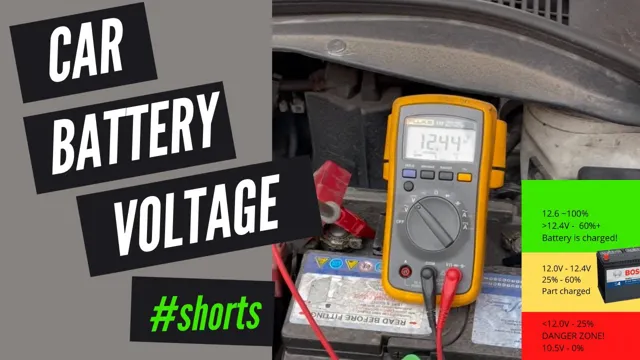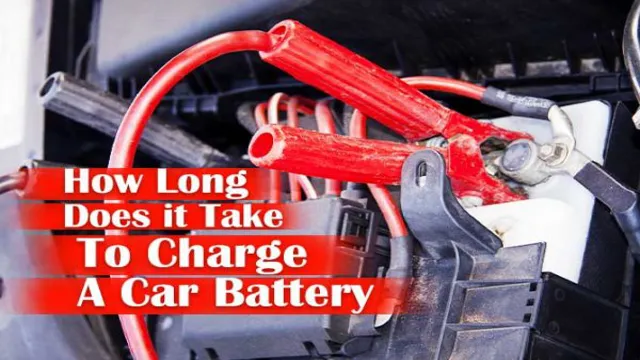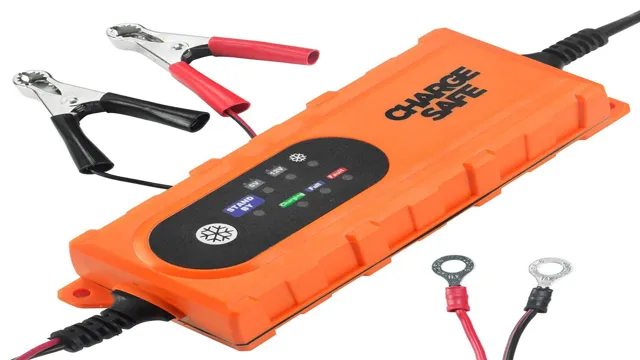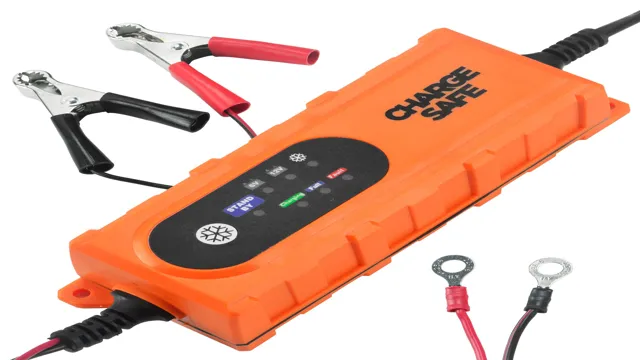What should a car battery charger read? A comprehensive guide to understanding optimal charging levels

If you’re a car owner, you know how important it is to keep your car battery charged. A dead battery could leave you stranded on the side of the road with no way to start your car. That’s why it’s essential to have a working battery charger at hand.
But how do you know if your car battery charger is working correctly? What should a car battery charger read? First, let’s start by understanding the role of a car battery charger. A car battery charger is an electronic device that delivers an electric charge to your car battery, allowing it to recharge. The charger works by converting an AC electrical supply into a DC electrical supply, which is then delivered to the battery.
The amount of charge delivered by the charger is measured in amps (A). A typical car battery charger will have a range of amperage settings, usually between 2 and 10 amps. However, the amperage delivered will depend on the charger’s capacity and the state of the car battery.
When charging your battery, the charger will display the current amperage being delivered to the battery. As the battery charges up, the amperage will gradually decrease, indicating that the battery is reaching full charge. Once the amperage drops to zero, the battery is fully charged and can be disconnected from the charger.
So, what should a car battery charger read? Ideally, you want the charger to read a constant amperage that’s within the range specified by the manufacturer. If the amperage is fluctuating or is either too high or too low, it could indicate a problem with the charger or the battery itself. Always refer to your charger’s manual for specific instructions on how to charge your battery correctly.
Understanding Voltage and Amperage
When it comes to charging your car battery, it’s important to know what your car battery charger should read. The two main factors to consider are voltage and amperage. Voltage is the electrical force that pushes the current through the battery, while amperage is the actual flow of current.
Your car battery charger should read a voltage between 12-14 volts and an amperage that corresponds with the battery’s capacity. For example, a 50-amp hour battery should be charged at 5 amps for ten hours. It’s important to remember that overcharging your battery can cause damage, so it’s essential to monitor the charging process closely.
By understanding voltage and amperage, you can ensure that your car battery charger is reading the correct levels, and your battery is being charged properly.
Voltage: The Key Measurement
Voltage is a crucial concept in understanding how electrical devices work. It’s defined as the electric potential difference between two points in an electrical circuit. To explain it in simpler terms, imagine water flowing through a pipe – voltage is the pressure that causes the water to flow.
A device with higher voltage will have more pressure and more potential energy to move electrons through a circuit. Amperage, on the other hand, refers to the rate of electron flow in a circuit, or the amount of electric charge moving past a point in a second. It’s measured in amperes and is equivalent to the number of electrons flowing through a wire, analogous to the amount of water flowing through a pipe.
Together, voltage and amperage determine the power of an electrical device, which is measured in watts. Understanding these two basic concepts – voltage and amperage – is necessary to comprehend how electrical devices operate and how they can be manipulated to fulfill different applications.

Amperage: The Charge Rate
When it comes to understanding your electronics, two important concepts you need to know are voltage and amperage. Amperage, also known as the charge rate, refers to the amount of electrical charge that flows through a circuit. It is measured in units called amperes, or amps for short.
Think of it like a river – the amount of water flowing through the river represents the amperage. The higher the amperage, the more quickly your device will charge. However, it is important to note that exceeding the recommended amperage for your device can lead to overheating and potentially damage the battery.
So, make sure to stick within the recommended amperage range to keep your devices safe and functioning properly.
Ideal Readings for a Car Battery Charger
Knowing what your car battery charger should read is crucial for keeping your battery in top condition. When selecting a charger, look for one that provides a reading of the current voltage, as well as the charging and maintenance mode. Your charger should be able to read the voltage of the battery while it is charging, as this will give you an idea of how fast the battery is charging.
As the charge approaches completion, the reading should gradually increase until it reaches a peak and then levels off. This indicates that the battery is fully charged and ready for use. Additionally, your charger should offer a maintenance mode, which keeps the battery at an optimal charge level without overcharging or undercharging it.
Keeping a close eye on these readings will extend the life of your battery and ensure that you’re always ready to hit the road.
Voltage: 12.6V to 12.8V
When it comes to charging a car battery, it’s important to know what readings to look for to ensure that the battery is charging properly. One of the most important readings is voltage, which should ideally be between 16V and 1
8V. If the voltage is too low, it may mean that the battery isn’t being charged enough, while too high a voltage could damage the battery. In addition to voltage, it’s also important to look for other readings such as amperage and resistance to ensure that the battery is receiving the right amount of power and not experiencing any issues.
By monitoring these readings, you can ensure that your car battery is properly charged and ready to go when you need it.
Amperage: Dependent on Battery Capacity
When it comes to car battery charging, one important factor to consider is the amperage, which is dependent on the battery’s capacity. It’s essential to have the ideal readings to avoid damaging the battery or charger. For example, a 12V battery typically requires a charger with amperage from 4-15A, while a higher voltage battery needs more amperage for faster charging.
However, it’s crucial to be cautious and not exceed the recommended amperage. It’s like filling a glass with water – too much water and it’ll spill over, while too little won’t fill it up. Similarly, the amperage should match the battery’s needs to avoid under or overcharging.
So, it’s imperative to understand the battery capacity and find a charger with the ideal amperage for efficient charging without damaging the battery.
Signs of a Problematic Car Battery Charger Reading
If you’re wondering what a car battery charger should read, the answer depends on the state of the battery and the type of charger. A fully charged battery should read around 16 to 1
8 volts. Generally, a good charger will detect when the battery drops below a certain voltage and begin to charge it to the optimal level. However, signs of a problematic car battery charger reading may include an abnormal voltage reading, a lack of response from the charger, or the battery simply not holding its charge after using the charger.
If you’re facing any of these issues, it’s best to check the charger’s manual for troubleshooting tips or to consider replacing it altogether. Remember, a healthy battery and reliable charger are crucial for keeping your car running reliably.
Low Voltage Readings
If you notice that your car battery charger is giving low voltage readings, that may be a sign of a problematic charger. Low voltage readings could mean that the charger is not charging the battery properly or that your battery may be faulty. One way to determine if the charger is the issue is to check the voltage readings while the charger is disconnected from the battery.
If the voltage readings are still low, then the charger is the problem. However, if the readings are normal, then the issue may lie with the battery. It’s important to address any issues with your car battery charger and battery promptly, as a malfunctioning charger or battery can lead to serious problems on the road.
So, be sure to keep an eye on your voltage readings and take action if anything seems off.
Insufficient or Excessive Amperage
When it comes to charging your car battery, one of the most important things to watch out for is the voltage reading. An insufficient or excessive amperage reading can be a sign of a problematic car battery charger. If the amperage reading is too low, your battery may not be charging properly, and if it’s too high, it could potentially damage the battery.
This can lead to issues such as decreased performance, shortened battery life, or even total failure of the battery. One way to ensure that you are getting a proper amperage reading is to use a quality battery charger that is designed specifically for your type of vehicle. Additionally, regular maintenance and monitoring of your battery can help you avoid potential issues before they become major problems.
By keeping an eye on your amperage readings, you can help extend the life of your car battery and avoid costly repairs down the road.
Final Thoughts
When it comes to car battery chargers, one of the most common questions people ask is “what should a car battery charger read?” Well, the answer is straightforward: a good car battery charger should read between 18V and 15V. This reading is considered healthy and ideal for your car battery to perform optimally.
However, it’s important to remember that the exact reading may vary depending on the charger’s brand or model. Additionally, some chargers may have multiple charging modes that can affect the reading you get. Therefore, it is essential to read the instructions carefully before using your charger and make sure you monitor the readings throughout the charging process.
Ultimately, keeping your car battery charged and healthy is crucial in ensuring your vehicle runs smoothly for years to come.
Conclusion
In conclusion, a car battery charger should read like a knowledgeable mechanic – confident, accurate, and ready to get the job done. It should display important information such as the current charge level, voltage, and any errors or warnings that may arise. And just like a mechanic, the charger should also offer helpful tips and suggestions to keep your battery running smoothly.
So the next time you plug in your car battery charger, keep an eye out for these features and trust that your trusty charger is doing its job like a pro.”
FAQs
What voltage should a car battery charger read?
A car battery charger should read a voltage between 12.6 and 14.8 volts.
How long does it take to charge a dead car battery?
The time it takes to charge a dead car battery depends on the charger and the battery’s capacity, but it can take anywhere from 30 minutes to several hours.
Can you overcharge a car battery with a charger?
Yes, overcharging a car battery with a charger can be harmful to the battery and shorten its lifespan.
How often should you charge a car battery?
It is recommended to charge a car battery at least once a month to maintain its health and prevent it from dying unexpectedly.
What type of charger is best for a car battery?
A smart charger is the best type of charger for a car battery as it can adjust the charging rate and prevent overcharging, which can damage the battery.
Can you charge a car battery while it is still connected to the car?
Yes, you can charge a car battery while it is still connected to the car, but you should ensure that the battery terminals are clean and securely connected to avoid any accidents.
Can a car battery be charged without a charger?
It is possible to charge a car battery without a charger, but it requires a power source with the correct voltage and amperage and proper safety precautions. It is not recommended for beginners or inexperienced individuals.



